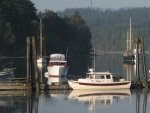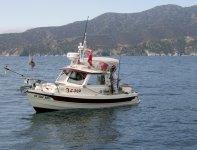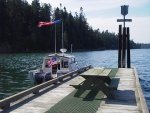I own the boat C-Pup that was in an earlier photo. For day cruising near port, it is comfortable as a two person boat. For overnight or any activity with gear in the boat, like an ice chest, fishing tackle or hoop nets, it is really just a one man boat. I enjoy it as my man cave on the ocean. I spent far more on the electronics and safety equipment on my boat than the boat itself cost new.
If you're taking your family to sea, especially across the Santa Barbara channel which can quickly become very rough and dangerous, then you need a 22 ft or 25 foot boat. There is no "easing into" boating by the size of the boat. You ease into it by starting with fair weather close to port excursion and taking boating safety and navigation classes. Next year, a new law will require you to pass a boating safety test and be licensed to operate a boat.
The 16 ft CD has a 700 something pound weight limit including motor, gas, people and gear. You really won't be able to pack enough gas along with the weight of passengers to get you to Santa Cruz Island and back. These boats pop up and plane on the water's surface, which gives them great miles per gallon. Below the maximum weight capacity however, there is a tipping point where they won't plane, but instead just plow, burning lots more gas per mile (reducing your range) and reducing your speed to a crawl.
Boating is a challenge, and doing it in a small boat is more of a challenge than in a bigger boat. It is often a pleasure, but always a lot to manage in terms of details (use check lists) and planning your excursions for safety. You need to know the forecast for swell direction and wind direction. In my 16 foot cruiser, I plan my excursions to travel at dawn when the ocean is flat to where I'll fish in Malibu. I choose Malibu because when I return to Marina del Rey the wind and swells are at my back, pushing me right to my destination. This is called traveling "downhill", and the flat bottom C0Dory does this very well. If I fish at Palos Verdes in the morning, I'll leave from Cabrillo boat ramp in San Pedro so I return to port "downhill" in the afternoon. If I tried to return to MdR in the chop and wind of afternoon, it could be slow, dangerous and physically torture to me and to my boat. The 16 ft C-Dory really can't handle up hill travel well. The 22 ft C-Dory handles it much better, The 25 foot Cruiser is an ice breaker and can take the perfect storm, though don't try that if you get one. For the safety of your family, get the biggest boat you can afford. If you want to be a hermit on the sea, then buy a 16 ft C-Dory and wear it like a body suit as I do.
Talk to Joel. He can offer you incredible insight from his vast experience with boats and boating people, and is the sweetest man of goodwill you'll encounter.
If you want to chat with me too, call me in Los Angeles at 323-291-7618
Be well,
Keith Dager
C-Pup16 in Los Angeles



